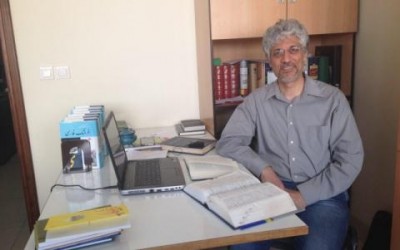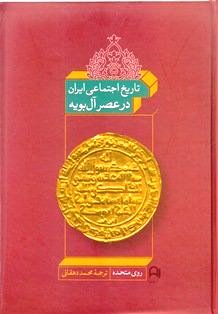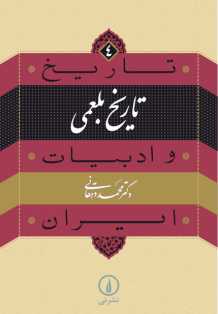Dr. Mohammad Dehghani is an outstanding scholar in medieval literature and history. He taught many courses in the Department of Literature at Tehran University. He has written many books including Hadith-i Khodawandi wa Bandegi on Bayhaqi, Tarikh-i Bal’ami and Shahnama-ya Abu Mansouri. In addition, he has translated many remarkable works into Persian such as Loyalty and Leadership in an Early Islamic Society by Roy Parviz Mottahedeh and Persian Historiography to the End of the Twelfth Century by Julie Scott Meisami. You can learn more about Dr. Dehghani in the following website: http://dmdehghani.ir
Dr. Mohammad Dehghani, it is my great pleasure to have an interview with you on the medieval Persian literature. One of the controversial subjects in Iranian studies is to determine the medieval ages. Based on the history of Persian literature, which period do you recognize as Iranian medieval times? Some historians divide this period into two eras of pre-Mongols and Post-Mongols. What is your idea in this regards?
If you mean “Middle Ages”, it started in the West around 4rth and 5th centuries to the Renaissance in the 16th century. It seems that we don’t have the same era with those peculiarities for our Persian literature.
To my idea, the history of medieval Persian literature started in the 10th century and ended in the 12th century. In this period, literature was so intertwined with the real life. Its language and styles were more epic, its similes, ironies, and metaphors were more tangible and its themes and motifs were more social and close to the problems of daily life. Then we arrived into a period which can be defined as medieval times. In this period, intellectual paradigm changed completely. Epic expressions gave its place to Mystical and lyrical language and expressions. There was more emphasis on individual ethics manifested in religious and mystical forms. Similes, ironies, and metaphors became more complicated and intangible. The literary forms became more diverse and were presented in educational aspects.
The medieval period was so long and lasted to the Qajar rule in early 19th century. Of course, we can divide it into two periods of pre-Mongols and post-Mongols and find the distinctive characteristic of Persian literature in each of these two periods. The early 19th century was the beginning of the modern Persian literature which had the same peculiarities as literature in Europe after the Renaissance. In other words, Renaissance started in Iran 300 years later.
In all your works there is a close connection between two disciplines of literature and history. To your idea, what are the linking rings between these two disciplines in medieval Persian works?
Two disciplines of literature and history either in medieval times or in modern times are inseparable. One of the main aspects of literature is its narration. History is a kind of narration as well; the main difference is that history claims that its theme is based on realities; but, literature is based not on realities but on fictions. However, we should take into account that the fictional narration is based on some real fields. It has relations and exchange with it's live and changeable surrounding where the history lives. If we separate the literary texts from its surrounding world, i.e. history and examine it in a distinguished context, like what the formalists and followers of new Criticism do, we will achieve remarkable findings. But it is just like analyzing a corpse in a lab to learn more about its physiologic structure. I personally prefer to analyze a literary text in its context rather than separating it from its real context as it is common in many literature classes.
You have done many valuable works on Tarikh-nama –ye Bal’ami. As you know there are a lot of controversies on Tarikh-I Bal’ami and its relation with Tarikh-I Tabari as a translation of this book from Arabic into Persian or a distinguished work. What is your idea in this regard?
I am so pleased that you used the word “valuable” for my work. But in fact, I express my own narration of the Persian literature. I do my best to base my narration on historical evidence rather than on ideology and personal beliefs. For Tarikh-i Bal’ami, I should say that it is not a translation of Tarikh-i Tabari but has its own theme and style. Tabari intends to have an Islamic and Arabic narration of history. It is worth mentioning that in the minds of most Muslims including Tabari Islam and Arab are the same. Bal’ami and his colleges are among those minorities that unlike Tabari aim at presenting an Iranian or at least non-Arab narration of history. As you see, we have two ideological understandings of history which are against each other in many aspects.
In Shahnama-ye Abu Mansuri, you have a comprehensive introduction to the genre of Shahnama. To your idea, can we extract some parts of Iranian medieval history out of this Shahnama or the works of Daghighi and Ferdowsi?
If you mean the “Middle Ages”, we cannot have reliable findings. Shahnama is Ferdowsi’s ideal narration of Iranian history in ancient and medieval times to his time in the 10th century. Part of its content is in accordance with other historical sources and even completes them. But, Shahnama essentially is not a historical work and Ferdowsi is a storyteller rather than a historian. Therefore, at the beginning of Shahnama, he asks the readers to regard his work not “lies and legends”. He knows that some of the readers may regard it as lies and legends. Like any other non-historical work, Shahnama is full of very good information about the history of culture and society in Iran. But we cannot regard Shahnama as a historical work.
In the book Hadith-i Khodawandi wa Bandegi, you have an unprecedented comprehensive introduction on Tarikh-i Bayhaqi. Can you explain a little about your viewpoint in this book? Why didn’t the method of historiography that Bayhaqi founded continue by next historians?
In this book, unlike common ideological nationalistic trends of researchers on Bayhaqi, I tried to show that he was dedicatedly served the Ghaznavids particularly Sultan Mansoud. He wrote Tarikh-i Bayhaqi to serve the Ghaznavids. Furthermore, in line with Tabari and unlike Bal’ami and Ferdowsi, he considers Islam and Arabs as equal. In other words, he does not have discriminative views about Ajam (Iranians) against Arabs. Unlike Ferdowsi, Bayhaqi does his best to distinguish between history and legends. He persists in providing a true report of events without going through interpretations. However, it is worth mentioning that despite all his skills, Bayhaqi is not the founder of any school in the Iranian historiography, since he didn’t have any students who follow his way. I think that we were so lucky to have some remnants of Bayhaqi’s heritage. The Ghaznavid dynasty collapsed very soon by the Saljuqs who were reluctant to retain books like Tarikh-i Bayhaqi admiring the Ghaznavids and their achievements. Independent historiography has been always regarded dangerous to the rulers so they rarely had the chance to survive.
You have done many remarkable translations on history and historiography. Persian Historiography to the End of the Twelfth Century by Julie Scott Meisami is one of these works in which you have precisely edited. How do you think it has contributed to the Persian Historiography?
The first strong point of Meisami’s work is that she has examined the Persian Historiography impartially. In other words, the reader does not feel that she has a special biased perspective. The second is that she presents the content of the book on the basis of a precise theory to provide readers with a clear picture of the themes and structures of medieval Persian Historiography. The third is that she compares the currents of Iranian historiography with the Europe’s which provides readers with an overall picture of what was going on in the Iranian and European’s world of historiography. The weak point of this work, on the other hand, is that Meisami has made some mistakes in translating the extracts of the Persian historical works into Persian; I have highlighted some of them in the footnote.
Loyalty and Leadership in an Early Islamic Society by Roy Parviz Mottahedeh is one of your outstanding translations. What inspired you to translate it into Persian?
Actually, the publisher encouraged me to translate it into Persian. It was previously translated into Persian, so first I denied doing it again. But when I compared the book with its translation I understood it is worth translating it again. It is a good example for examining the social and political history of Iran after Islam. I wished he continued this kind of research for periods after the Buyids .
Can you explain a little about your new works?
Nowadays, I am working on the project of History and Literature of Iran. Six works of it have been published until now. In addition, I am doing some translations such as Dangerous Knowledge: Orientalism and Its Discontents by Robert Irwin which is about the dangers of Orientalism. It’s going to be published at Mahi publication.
Please mention if there are any further points.
I wish you the best and thank you for reading my works.
Thank you too for your consideration and time.
Interviewed by: Maryam Kamali



